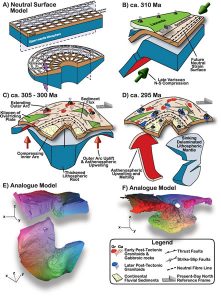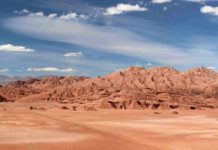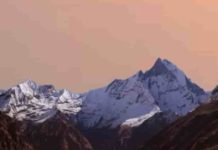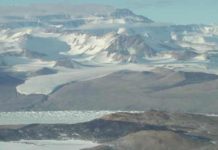
Mountain belts on Earth are most commonly formed by collision of one or more tectonic plates. The process of collision, uplift, and subsequent erosion of long mountain belts often produces profound global effects, including changes in regional and global climates, as well as the formation of important economic resources, including oil and gas reservoirs and ore deposits. Understanding the formation of mountain belts is thus a very important element of earth science research.
One common but poorly understood aspect of mountain belts are the many examples of curved (arcuate) mountain ranges. The Appalachian range in Pennsylvania, the Rocky Mountains in central Montana, the Blue Mountains in Oregon, the Bolivian Andes of South America, and the Cantabrian Arc in Spain and northern Africa are among many examples of noticeably curved mountain belts.
The cause of these curvy mountains is among the oldest topics of research in geology, and there is still extensive debate on what mechanisms are most important for making a curvy mountain range.
A common question is whether these presently curvy mountain ranges were originally straight and then later bent or whether they were uplifted in more or less their present shape.
Another important aspect of the origin of these curved mountain ranges is the thickness of the rock units involved in their formation. Some workers have proposed that these ranges are composed of relatively thin slices of crustal rocks (limited to several kilometers in thickness), while others have argued that at least some of these curvy ranges involve the entire thickness of the lithospheric plates (30 to 100 km thick). One of the most promising ways to answer these questions utilizes comparisons of the orientation of structural features in rocks (fault planes and joints), records of the ancient magnetic field directions found in rocks, and the timing of deformation and uplift of the mountain belts.
An international group of researchers from Spain, Canada, and the United States, led by Dr. Gabriel Gutiérrez-Alonso, have presented a compelling study of one of the best examples of curved mountain ranges: the Cantabrian Arc in Spain and northern Africa. They have compiled an extensive collection of fault and joint orientation data and directions of the ancient geomagnetic field recorded by Paleozoic rocks collected in Spain.
The Cantabrian Arc was formed during the collision of a southern set of continents (Gondwanaland [present day Africa-South America-Australia-India-Antarctica]) with a northern set of continents (Laurentia [present day North America and Eurasia]) to produce the supercontinent Pangea. In a nutshell, their combined study has found that the curved pattern of the Cantabrian Arc was produced by the bending of an originally straight mountain range.
The main line of evidence supporting this view is the patterns of rotation that are obtained from the directions of the ancient geomagnetic field recorded by the rocks of these mountain ranges. Combined with an analysis of the faults and joints in the rocks, and the ages of rocks that have variations in the amount of rotation indicated by the magnetic directions, the age of the bending of the Cantabrian Arc is confined to a relatively narrow window of geological time between 315 and 300 million years ago.
Gutiérrez-Alonso and colleagues compare the age range of this mountain bending event to the ages of igneous activity and uplift of the region and propose that widespread changes in the deeper (mantle) portion of the lithospheric plate in the area are coeval, and likely linked to, the rotation of the Cantabrian Arc to produce its characteristic sharp curviness. Based on this linkage, they propose that this, and perhaps many other, curvy mountain ranges are produced by rotation of entire portions of the lithosphere of tectonic plates, rather than just thin slices of crustal rocks.
Note : The above story is reprinted from materials provided by Geological Society of America.










